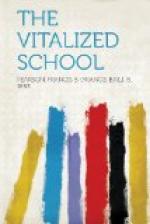=Language and vitality.=—When she is teaching a language, it is never less than a living language. In Latin the syntax is learned as a means, never an end. The big things in the study loom too large for that. The pupils become so eager to see what Caesar will do next that they cannot afford the time to stare long at a mere ablative absolute. They are following the parade, and are not to be turned aside from their large purpose by minor matters. They are made to see and hear Cicero; and Rome becomes a reality, with its Forum, its Senate, and its Mamertine. When Dido sears the soul of the faithless AEneas with her words of scorn, the girls applaud and the boys tremble. When Troy burns, there is a real fire, and Achates is as real as the man Friday. When the shipwrecked Trojans regale themselves with venison, it is no make-believe dinner, but a real one. Where such a teacher is, there can be no dead language, no dry bones of history, and no stagnation in the stream of life.
QUESTIONS AND EXERCISES
1. What suggestions are offered for the vitalization of mathematics? history? reading? language?
2. In what ways is vitalization of subject matter related to its socialization?
3. How may motivation in teaching the multiplication table be assisted by vitalization?
4. What is to be included in the term “read” in the sentence “She can teach reading because she can read”?
5. Add to the author’s list of children in literature whom the vitalized teacher may introduce as companions to her pupils.
6. Why is extended reading essential to success in teaching?
7. What works of Dante have you read? of Victor Hugo? of Shakespeare? How will the reading of such authors improve the teaching ability of elementary teachers?
8. What are the distinguishing characteristics of the vitalized teacher?
CHAPTER III
THE CHILD
=The child as the center in school procedure.=—The child is the center of school procedure in all its many ramifications. For the child the building is erected, the equipment is provided, the course of study is arranged and administered, and the teacher employed. The child is major, and all else is subsidiary. In the general scheme even the teacher takes secondary place. Teachers may come and go, but the child remains as the focus of all plans and purposes. The teacher is secured for the child, and not the child for the teacher. Taxpayers, boards of education, parents, and teachers are all active in the interests of the child; and all school legislation, to be important, must have the child as its prime objective. Colleges of education and normal schools, in large numbers, are working at the educational problem in an effort to develop more effective methods of training the teachers of the child. A host of authors and publishers are giving to the interest of the child the products of their skill. In every commonwealth may be found a large number of men and women whose time and energies are devoted to the work of the schools for the child.




